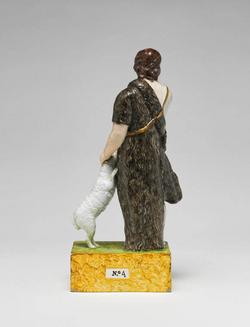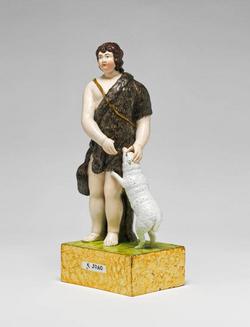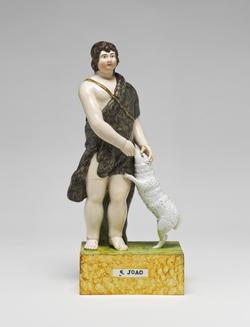Current Location: In storage
Titles
Saint John the Baptist
Maker(s)
Production:
Lakin & Poole
(Possibly)
Entities
Categories
Description
Pearlware figure of St John the Baptist on a high pedestal, painted in polychrome enamels
Earthenware moulded and modelled, with slightly blue tinted lead-glaze (pearl glaze), painted with flesh-pink, brown, yellow, green and red enamels. St. John the Baptist standing on a high square base. His hair is brown and curly. He wears a brown animal-skin garment over his left shoulder and a strap or belt over his right. His left hand rests on the head of a sheep which is climbing up his side. The hair, animal skin and sheep’s fur are modelled in relief. The oblong base is marbled, yellow on the sides and green on the top. The front of the base is labelled ‘S.JOAO’ and the back ‘No. 4’, both labels impressed and painted black on a reserved area of white. The underside of the base is deeply recessed and glazed, with two small vent holes towards the back.
Notes
History note: Bought from Mr F..J. Morrell, 48 Liverpool Road, Stoke-upon-Trent, on 24 October 1911, for £2.10s or £2.15s (two pounds and ten or fifteen shillings)., by Dr J.W.L. Glaisher, Trinity College, Cambridge.
Legal notes
Dr. J.W.L. Glaisher Bequest, 1928
Measurements and weight
Height: 22.9 cm
Acquisition and important dates
Method of acquisition: Bequeathed
(1928)
by
Glaisher, J. W. L., Dr
Dating
1790s
Circa
1791
-
Circa
1796
Note
Pearlware figures decorated with enamels were in production by 1780. They were generally made at smaller potteries and are rarely marked. A cheaper alternative to porcelain figures, they drew on a variety of sources, including sculpture and porcelain figures. Classical, biblical, mythological and literary subjects were popular, as were animals and representations of rural life, seasons and trades. From the early 19th Century, scenes from everyday life and topical events were also common. These early figures are moulded, perhaps with moulded or modelled parts added, the bases often formed separately. By c.1835, these early methods had largely given way to three-part press-moulding, which enabled cheaper, mass production of figures for a growing market.
The label ‘S.JOAO’ indicates that this figure was made for export, perhaps to Portugal or Brazil. Dr Glaisher thought it ‘ a really good specimen…[it] took my fancy from the careful modelling of the face, and the sheep in general style’. Both he and Bernard Rackham attribute it to Lakin and Poole of Burslem, citing the rectangular, marbled plinth and the careful modelling. This would indicate an early date, as the partnership of Lakin and Poole lasted only from 1791-1795 although the firm continued until 1797. Their goods included blue-printed and cream earthenware, black basalts and ‘figures in great variety’. Halfpenny’s description of their figures as ‘plump ... with slightly protruding eyes’ could apply here, although the marbling and labelling of the base seems less refined than on marked Lakin and Poole examples.
Components of the work
Decoration
composed of
lead-glaze
( blue tinged)
enamels
Parts
Materials used in production
White earthenware
Techniques used in production
Moulding
: White earthenware, moulded and modelled, lead glazed and painted with polychrome enamels.
Inscription or legends present
- Text: S. JOAO
- Location: Front of base
- Method of creation: Impressed and painted black
- Type: Label
- Text: No. 4
- Location: Back of base
- Method of creation: Impressed and painted black
- Type: Label
- Text: 4557 Staffordshire figure of St John the Baptist b. at Stoke on Trent June 4 1925.
- Location: Underside of base
- Method of creation: Rectangular paper lable handwritten in black ink
- Type: Label
References and bibliographic entries
Identification numbers
Accession number: C.946-1928
Primary reference Number: 76426
Old object number: 4557
Stable URI
Audit data
Created: Saturday 6 August 2011
Updated: Monday 4 August 2025
Last processed: Monday 4 August 2025
Associated departments & institutions
Owner or interested party:
The Fitzwilliam Museum
Associated department:
Applied Arts

 IIIF Manifest
IIIF Manifest








